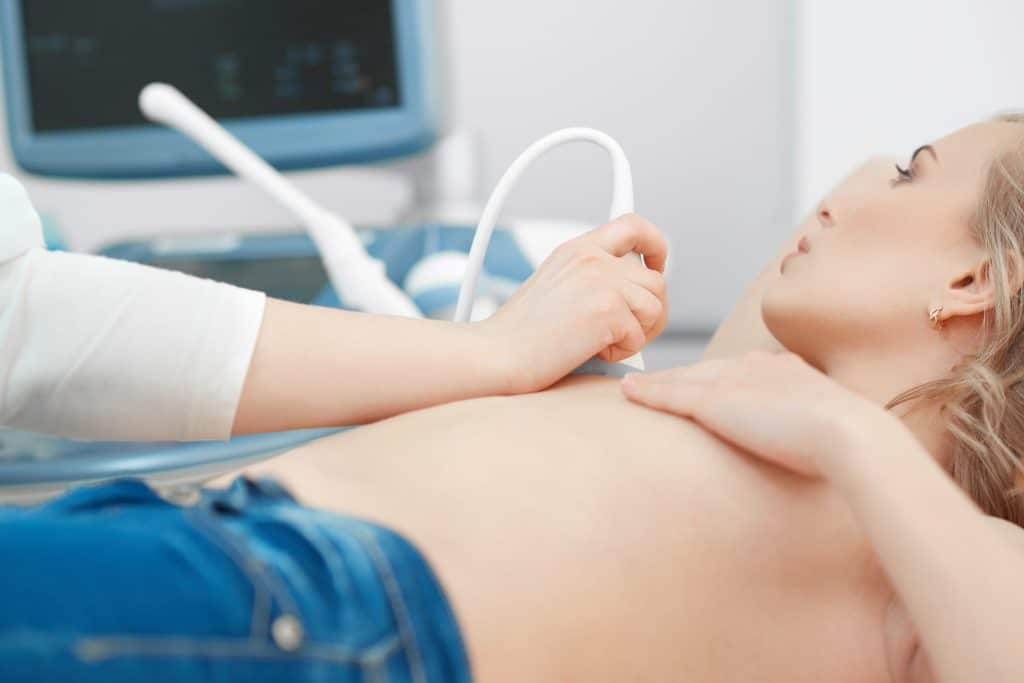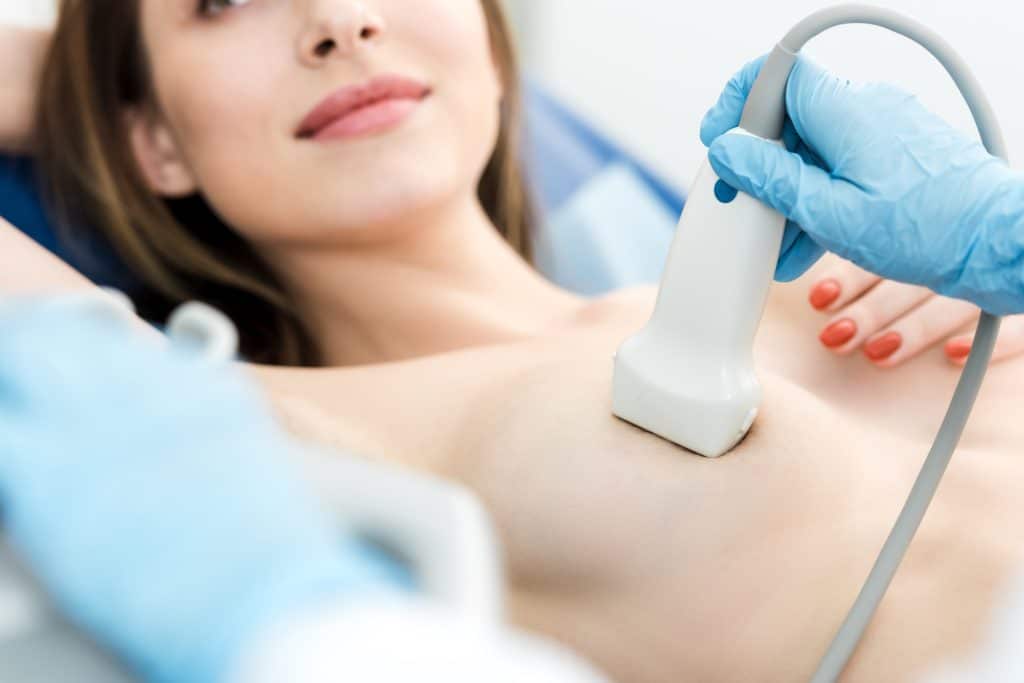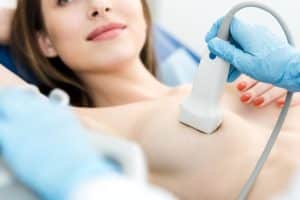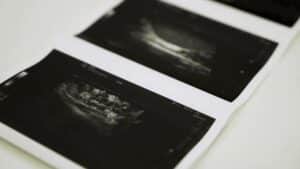Breast ultrasound is a non-invasive and painless imaging technique that...
Read MorePrivate Breast Ultrasound in London
An unexpected change, a new lump, or persistent pain in your breast can cause significant worry.
We provide a specialist, private breast ultrasound service in London designed to give you clear, accurate answers without the wait.
Our clinic offers rapid access to expert consultants who can provide you with a full report and peace of mind on the same day.
What is the Cost of a Private Breast Scan?
- Single breast ultrasound: £189
- Both breasts ultrasound: £269
(Includes full report & consultation)
✓ CQC Registered | ✓ GMC Registered | ✓ No GP Referral Required| Same-Day Appointments usually Available| ✓ Same-Day Report

What is Breast Ultrasound?
Breast ultrasound (US) is a vital imaging modality in the detection and evaluation of breast disease, particularly in women with dense breast tissue.
Recent advances, including elastography and artificial intelligence (AI), have significantly improved its diagnostic accuracy and specificity.
Breast cancer remains the most common malignancy in women worldwide. Imaging plays a crucial role in early detection, diagnosis, and management. While mammography is the primary screening tool, ultrasound offers complementary diagnostic capabilities, especially for characterizing palpable masses and evaluating dense breast tissue (Lan & Peng, 2022)
Breast ultrasound utilizes high-frequency sound waves to produce real-time images of breast tissue.
It is safe, non-invasive, and does not use ionising radiation.
The modality allows dynamic evaluation of lesions and is especially useful in guiding interventional procedures.
What are the benefits and Limitations of the breast ultrasound?
Ultrasound helps differentiate cystic from solid masses and characterises suspicious features such as margins, shape, and internal echotexture. In younger women and those with dense breasts, it can detect abnormalities not visible on mammography.
For women with dense breast tissue, ultrasound increases cancer detection rates when added to mammography
However, ultrasound does not replace mammography; some early cancers only show as microcalcifications on mammogram. False positives can occur, leading to follow‑up tests.
While conventional US has high sensitivity, its specificity is limited, leading to unnecessary biopsies.
Studies report sensitivities above 85% but specificities as low as 40% in some cases.
Limitations
Operator dependency and variability in image acquisition and interpretation.
Limited sensitivity in detecting microcalcifications compared to mammography.
High false-positive rates with conventional ultrasound alone.

Why would you need a breast ultrasound in london?
Our breast ultrasound provides detailed evaluation of your breast tissue, helping to identify or rule out various conditions that may be causing your symptoms.
What We Scan For:
✓ Breast Lumps and Masses
Distinguishing between solid masses and fluid-filled cysts—the most common reason for breast ultrasound.
✓ Cysts vs. Solid Tumours
Ultrasound can definitively identify simple cysts (benign fluid-filled sacs) and characterise solid masses that may require further evaluation.
✓ Fibroadenomas
Common benign breast lumps that most frequently affect younger women. Ultrasound can usually identify these with characteristic features.
✓ Nipple Discharge Investigation
Evaluation of the ducts behind the nipple to identify the cause of spontaneous discharge.
✓ Breast Pain Evaluation
Assessment of breast tissue in areas of persistent pain or tenderness to rule out underlying abnormalities.
✓ Breast Implant Integrity Checks
Comprehensive examination of breast implants to detect ruptures, leaks, or complications including BIA-ALCL (breast implant-associated anaplastic large cell lymphoma).
✓ Axilla (Armpit) Lymph Nodes
Examination of lymph nodes in the armpit region, which is included in every breast ultrasound to provide complete assessment.
✓ Post-Surgical Changes
Monitoring of breast tissue following previous surgeries, biopsies, or lumpectomies.
✓ Mastitis and Abscesses
Identification of infections or fluid collections, particularly in breastfeeding women.
✓ Male Breast Concerns
Evaluation of gynecomastia (enlarged breast tissue in men) or lumps in male breast tissue.
When is Breast Ultrasound Recommended?
Breast ultrasound is the preferred imaging method in several situations:
- Age under 35 – Ultrasound is more effective than mammography in younger women with denser breast tissue
- Dense breast tissue – When mammograms are difficult to interpret due to tissue density
- Pregnancy or breastfeeding – Ultrasound uses no radiation, making it completely safe
- Supplementary to abnormal mammogram – To further evaluate areas of concern identified on mammography
- Palpable breast lump – To characterise any lump you or your doctor can feel
- Male breast evaluation – For investigation of gynecomastia or breast masses in men
- Transgender patients on hormone therapy – Monitoring breast tissue changes in trans women
- Routine breast implant monitoring – FDA recommends ultrasound at 5-6 years post-surgery, then every 2-3 years
- Follow-up of known benign findings – Monitoring previously identified cysts or fibroadenomas
- Breast pain with no lump – Assessment when pain is persistent or localised
- Family history of breast cancer – Supplementary screening for high-risk individuals, especially those who cannot undergo MRI

Who will perform my Scan?
Your Scan is Performed by Dr. Jalaleddin
Every breast ultrasound at IUS London is personally conducted by Dr. Jalaleddin, an experienced specialist in diagnostic imaging. This means you receive consultant-level expertise from the moment you arrive.
Professional Background
Dr Mohammad Jalaleddin (GMC registration number: 7729988) is an internationally trained physician who earned his medical degree from the prestigious Tishreen University in Syria in 2005. His journey in diagnostic radiology began with specialisation completed in 2009, followed by a Master's degree in 2011 with focused research on radiological alterations of bone grafts.
His professional career spans various hospitals and clinics, during which he has developed exceptional expertise in ultrasound and MRI scans. These advanced imaging modalities provide remarkable clarity into human anatomy and have been instrumental in formulating precise diagnoses and treatment plans throughout his career.
Professional Memberships
Dr. Jalaleddin maintains active membership in prestigious professional organizations:
- General Medical Council (GMC)
- British Medical Ultrasound Society (BMUS)
Since relocating to the UK in 2017 and completing the rigorous requalification process through the General Medical Council examinations, Dr. Jalaleddin has been contributing his expertise to Imperial College Healthcare NHS Trust since March 2021. His commitment to excellence in radiology and patient care drives his practice at International Ultrasound Services.
"My approach combines technical excellence with compassionate care. I understand that coming for a breast scan can be anxiety-provoking, so I take time to listen to your concerns, explain what I'm seeing during the examination, and answer all your questions in plain English—not medical jargon. You're not just a scan appointment; you're a person who deserves clarity and reassurance." —
Dr. Jalaleddin
Patient Reviews
Find out why we are the Top-Rated ultrasound provider in London.
- - Maaysa ;@ Schulling11/10/2025Just had my first scan, Dr welcomed me and was very kind and friendly, definitely would recommend!Read MoreRead LessSahar Zin10/25/2025Smooth, professional, friendly and super quick in delivering reports for a very reasonable price! Thank you!Read MoreRead LessK and all that glitters k.10/20/2025I had my first breast ultrasound, I was nervous and I had a really good first experience .Thank you.Read MoreRead Less
- Valentina NU?EZ10/20/2025I would like to thank and also to strongly recommend Dr Kiromitis today. Not only he has been very professional and helpful but also made me feel very confortable throughout my whole ultrasound + answer all the questions and concerns I had. Very professionals.Read MoreRead LessKamil Koszela10/20/2025I had a very positive experience at this private ultrasound practice. Mr. Y. Kiromitis, PgCert, BSc(Hons), was exceptionally professional and made me feel comfortable throughout the appointment. Provided clear guidance, explained each step, and offered genuine reassurance, which helped put me at ease. Overall, a highly professional and caring service that I would strongly recommend.Read MoreRead LessElina Lazyrik10/15/2025Very pleasant and professional service. The website is very easy to use, and booking an appointment takes just a few minutes. There are many time options available throughout the day, including convenient evening slots. The clinic is also easy to find and very well organised. Highly recommend!Read MoreRead Less
Why Choose IUS London for Your Breast Ultrasound?
| Feature | IUS London | NHS | Other Private Clinics |
|---|---|---|---|
| Waiting Time | Same day or next day | 2-6 weeks | 3-7 days |
| Performed By | Specialist Doctor (Dr. Jalaleddin) | Sonographer or Radiologist | Varies (often sonographer) |
| Appointment Length | 30 minutes | 20 minutes | 20 minutes |
| Results | Same day - immediate discussion | 1-2 weeks | 2-3 days |
| Written Report | Comprehensive, same day | Standard, 1-2 weeks | Varies, 2-3 days |
| Cost | £189-£269 (transparent) | Free (if eligible via GP referral) | £150-£350 (often unclear) |
| Referral Required | No | Yes (GP referral) | Usually no |
| Direct Access | Yes - throughout your care | No | Sometimes |
| Consultation Included | Yes - before and after scan | Limited | Varies |
We provide the same level of expertise as major London hospitals—without the corporate overhead, long waiting times, or impersonal conveyor-belt approach.
When you choose IUS London, you're choosing:
✓ Speed – Same-day and next-day appointments available
✓ Expertise – Consultant-level care from a specialist doctor
✓ Personal attention – 30-minute appointments, not rushed 20-minute slots
✓ Immediate answers – Same-day results and face-to-face discussion
✓ Transparency – Clear pricing with no hidden fees
✓ Accessibility – No GP referral required, direct booking
✓ Convenience – Central London location near Notting Hill Gate
✓ Quality – Latest ultrasound technology and CQC registration
Your Questions Answered
How accurate is breast ultrasound at detecting cancer?
Breast ultrasound has approximately 95% sensitivity for distinguishing between cysts and solid masses—which is its primary diagnostic strength. For cancer detection specifically, ultrasound is most effective when used alongside clinical breast examination and, for women over 40, mammography.
Ultrasound excels at:
- Evaluating palpable lumps (lumps you can feel)
- Assessing dense breast tissue where mammograms may be unclear
- Distinguishing fluid-filled cysts from solid masses
- Characterizing masses found on mammograms
Research published in the American College of Radiology's journal confirms that ultrasound increases detection rates of small invasive cancers not visible on mammography, particularly in women with dense breast tissue. However, ultrasound has limitations—it cannot reliably detect microcalcifications (tiny calcium deposits that can be early cancer signs), which is why mammography remains important for women over 40.
The bottom line: Ultrasound is an excellent diagnostic tool, particularly for younger women and for evaluating specific concerns. Dr. Jalaleddin will recommend whether additional imaging (mammogram or MRI) is advisable based on your individual situation.
What if you find something suspicious during my scan?
First, please know that Dr. Jalaleddin will be honest and clear with you about any findings—you won't be left in the dark or worrying unnecessarily.
If the ultrasound reveals concerning findings that require further investigation, here's what happens:
1. Immediate explanation – Dr. Jalaleddin will explain what he sees on the images and specifically why the finding needs further evaluation.
2. Clear next steps – He'll outline what additional tests are needed, which typically include:
- Biopsy (tissue sample for laboratory analysis)
- Additional imaging (mammogram or MRI if not already done)
- Referral to a breast surgeon or specialist
3. Rapid referral – We can often arrange next-day or same-week appointments with breast surgeons. You won't face weeks of waiting.
4. Coordination of care – We'll provide a detailed report for your specialist and remain available for questions throughout your care journey.
5. Continued support – Dr. Jalaleddin and our team are here to support you. You can contact us with questions even after your appointment.
Important to remember: Finding something that needs further investigation does NOT mean it's cancer. Many suspicious findings turn out to be benign on biopsy. However, when something does need investigation, rapid action and expert care significantly improve outcomes.
Early detection saves lives. If there's something that needs attention, we'll ensure you get the expert care you need without delay.
How does your service compare to NHS breast clinics?
This is an important question. The NHS provides excellent breast cancer diagnosis and treatment—some of the best in the world. Our service is not a replacement for the NHS; rather, we provide rapid access to initial diagnosis when waiting times would otherwise cause prolonged anxiety.
Key differences:
Timing:
- IUS London: Same-day or next-day appointments
- NHS: Typically 2-6 weeks for routine referrals (urgent suspected cancer referrals are seen within 2 weeks under NHS guidelines)
Who performs the scan:
- IUS London: Dr. Jalaleddin (specialist doctor) performs every scan personally
- NHS: Usually a trained sonographer or radiographer performs the scan; a radiologist reviews images and provides the report
Appointment time:
- IUS London: 40-minute appointments with consultation before and after
- NHS: Typically 20-minute appointment slots
Results:
- IUS London: Immediate discussion of findings; written report same day
- NHS: Results usually provided 1-2 weeks later via letter or GP
Access:
- IUS London: No GP referral needed; direct booking
- NHS: Requires GP referral (except for some breast screening programs)
Follow-up if needed:
If we identify something requiring treatment or further investigation, you can choose to:
- Return to NHS for follow-up care (we'll send your report to your GP for urgent referral)
- Continue privately with a specialist we recommend
Many of our patients use our service for rapid diagnosis, then continue their care through the NHS if treatment is needed. The NHS is excellent for ongoing cancer treatment—our role is to provide fast initial answers when waiting isn't bearable.
Can men have breast ultrasounds?
Absolutely. Breast ultrasound is equally effective for examining breast tissue in men. While breast cancer is much less common in men (about 1 in 1,000 men will develop it during their lifetime), men can experience various breast concerns including:
Gynaecomastia – Enlarged breast tissue, which can be caused by hormonal changes, medications, or medical conditions. Ultrasound can confirm the diagnosis and rule out other causes.
Breast lumps – Any palpable lump in male breast tissue should be evaluated to rule out the rare possibility of male breast cancer.
Breast pain – Ultrasound can identify any underlying cause of persistent breast or chest pain.
Nipple discharge – Though rare in men, any nipple discharge should be investigated.
Dr. Jalaleddin has extensive experience performing breast ultrasounds on patients of all genders and provides the same thorough, professional care regardless of gender.
Men are often hesitant to seek help for breast concerns due to stigma or embarrassment.
Please know that you'll be treated with complete professionalism and respect—breast concerns in men are more common than you might think, and we're here to provide the answers you need.
Is this suitable for transgender and gender-nonconforming individuals?
Yes, absolutely. We provide welcoming, respectful, and clinically appropriate care for transgender and gender-nonconforming individuals.
For trans women and transfeminine individuals:
Hormone replacement therapy (HRT) with oestrogen causes breast tissue development. This breast tissue should be monitored just like in cisgender women, particularly if you:
- Notice a lump or change in your breast tissue
- Experience breast pain or nipple discharge
- Have been on HRT for several years and want routine screening
- Have a family history of breast cancer
Research shows that trans women on long-term HRT have increased breast cancer risk compared to cisgender men (though still lower than cisgender women). Breast ultrasound is an appropriate screening and diagnostic tool.
For trans men and transmasculine individuals:
If you've had top surgery (chest masculinisation), a small amount of breast tissue typically remains. Any lumps, pain, or concerns in the chest area can be evaluated with ultrasound. Even after mastectomy, residual breast tissue can develop problems that warrant investigation.
If you haven't had top surgery, breast ultrasound can evaluate any concerns in the same way as for cisgender women.
Our approach:
Dr. Jalaleddin understands the unique healthcare needs of transgender patients. He will:
- Use your correct name and pronouns
- Respect your privacy and dignity
- Understand how hormone therapy affects breast tissue
- Provide clinically appropriate care tailored to your individual situation
- Create a safe, affirming healthcare environment
You deserve compassionate, competent healthcare without fear of discrimination or misunderstanding. That's what we provide.
What's the difference between ultrasound and mammogram?
This is one of the most common questions we receive. Both are valuable breast imaging tools, but they work differently and are suited to different situations.
Breast Ultrasound:
- How it works: Uses high-frequency sound waves to create images
- Radiation: None—completely radiation-free
- Best for: Dense breast tissue, women under 40, evaluating specific lumps, pregnancy/breastfeeding, characterizing findings from mammograms
- Strengths: Excellent for distinguishing cysts from solid masses; can detect lesions in dense tissue where mammograms struggle; real-time imaging
- Limitations: Cannot reliably detect microcalcifications; dependent on operator expertise; cannot image the entire breast in one view
Mammogram:
- How it works: Uses low-dose X-rays to image breast tissue
- Radiation: Yes—low dose, but radiation exposure
- Best for: Routine screening in women 40+, detecting microcalcifications, imaging large areas of breast tissue
- Strengths: Can detect early cancers before they're palpable; shows microcalcifications; standardized images allow easy comparison over time
- Limitations: Less effective with dense breast tissue; requires breast compression (can be uncomfortable); uses radiation; less accurate in women under 40
When are they used together?
Often, mammogram and ultrasound are complementary:
- A mammogram might identify an area of concern that ultrasound can further characterize
- Women with dense breasts may need ultrasound in addition to mammography for complete screening
- If a lump is felt but not visible on mammogram, ultrasound is used for further evaluation
Which do you need?
- Under 35 with a breast lump: Ultrasound is typically the first-line imaging
- Age 35-40 with a breast lump: Often both ultrasound and mammogram
- Over 40 with a breast lump: Typically both mammogram and ultrasound
- Routine screening over 40: Mammogram (ultrasound added if dense breasts or if mammogram shows concerns)
- Pregnant or breastfeeding: Ultrasound (avoids radiation)
Dr. Jalaleddin will recommend whether you also need a mammogram based on your age, symptoms, and ultrasound findings.
Will the ultrasound hurt if I have a painful lump?
This is an understandable concern, especially if your breast is already tender. The good news is that breast ultrasound is generally painless, even when you have a sore area.
The ultrasound probe applies gentle pressure to your breast as it moves across the surface. For most patients, this feels like a light, comfortable pressure—many describe it as similar to a gentle massage.
If you have a tender lump or sore area:
- Dr. Jalaleddin will adjust his technique to minimise discomfort
- He can modify the pressure used in sensitive areas
- The gel acts as a lubricant, so the probe glides smoothly without friction
- The examination typically takes 15-20 minutes, so even if slightly uncomfortable, it's brief
Most patients with painful lumps report that the ultrasound causes minimal to no additional discomfort. The psychological relief of getting answers usually far outweighs any mild physical discomfort during the scan.
Please communicate: If you experience discomfort at any point during the examination, tell Dr. Jalaleddin immediately. He can adjust the pressure or take a brief pause. Your comfort is important.
Do I need to take time off work for this appointment?
For most patients, no significant time off work is necessary. Many of our patients schedule appointments during lunch breaks or before/after work hours.
Time needed:
- The appointment itself: 20-30 minutes
- Travel time: Depends on your location (we're 5 minutes from Notting Hill Gate station)
- Total time away: Typically 1-2 hours including travel
After the scan:
- No recovery time needed
- You can return to work immediately
- You can drive, exercise, and resume all normal activities
- No side effects or aftereffects
What if I'm breastfeeding?
Breast ultrasound is completely safe during breastfeeding and does not affect milk production or quality. In fact, ultrasound is the preferred imaging method for lactating women because:
- It uses no radiation (unlike mammography)
- It can effectively evaluate breast tissue even when engorged with milk
- It's excellent for detecting mastitis, abscesses, or blocked ducts
- It won't interfere with breastfeeding schedules
Tips for breastfeeding mothers:
- You may want to nurse or pump before your appointment for comfort
- The ultrasound gel is water-based and easily wipes off—it won't affect breastfeeding
- If you need to nurse during or after the appointment, private space is available
- You're welcome to bring your baby to the appointment if needed
Common breast concerns in breastfeeding women we evaluate:
- Mastitis (breast infection)
- Breast abscesses
- Blocked milk ducts
- New lumps or masses (which need evaluation even if you're breastfeeding)
- Persistent pain or redness
If you're experiencing breast concerns while breastfeeding, don't delay getting evaluated. Early diagnosis of infections or abscesses can prevent complications and help you continue breastfeeding successfully.
When will I receive my results?
Unlike many clinics where you wait days or weeks for results, at IUS London you receive your results in two ways:
1. Immediate verbal discussion (during your appointment):
Dr. Jalaleddin discusses findings with you immediately after completing the scan—while you're still in the examination room. He'll show you the images and explain in clear language what he's seen. This means you leave the appointment with answers, not anxiety about waiting.
You'll know before you leave:
- Whether any lumps are cysts or solid masses
- Whether findings appear benign or need further investigation
- What the next steps are (if any)
- Answers to all your questions
2. Written report (same day):
Within hours of your appointment—typically by end of business day—you'll receive a comprehensive written report via email.
Your report includes:
- Detailed description of ultrasound findings
- Clinical interpretation and assessment
- Recommendations for follow-up (if needed)
- High-resolution images from your scan - If needed
- Contact information for any questions
You can save this report for your records, share it with your GP, or forward it to any specialist.
No waiting in limbo. No days of anxiety wondering about results. Just clear, immediate answers.
Is breast ultrasound covered by insurance?
Most private health insurance plans cover breast ultrasound when medically necessary—meaning when you have symptoms (lump, pain, discharge, etc.) or when it's recommended due to family history or previous breast concerns.
Important points about insurance coverage:
Some insurers require pre-authorisation before your appointment. Check with your insurer regarding their specific requirements. We can provide any necessary documentation to support your claim.
Policy excess: Most policies have an excess (the amount you pay before insurance coverage begins). Make sure you understand your excess amount.
Coverage criteria: Insurance typically covers diagnostic ultrasound (when you have symptoms) but may not cover purely screening ultrasound if you're asymptomatic. Check your specific policy.
Claim process: We provide detailed invoices with all necessary information for you to submit to your insurer for reimbursement or direct billing (if your policy allows).
Self-pay option: If you don't have insurance or prefer not to use it, our transparent pricing (£189-£269) allows you to pay directly without insurance complexity.
We recommend contacting your insurance provider before booking to confirm:
- Whether breast ultrasound is covered under your policy
- Whether pre-authorization is required
- What your excess payment will be
Our team is happy to provide any information your insurer needs to process your claim.
What if I have dense breast tissue?
Dense breast tissue is very common—about 40-50% of women have dense breasts. Having dense breasts is not abnormal, but it does have implications for breast imaging and cancer risk.
What does "dense breast tissue" mean?
Breasts contain a mixture of fatty tissue, glandular tissue, and connective tissue. Dense breasts have proportionally more glandular and connective tissue relative to fatty tissue. Breast density is classified into four categories (A through D), with C and D being considered dense.
Why does breast density matter?
Mammography limitations: Dense tissue appears white on mammograms—and so do tumours. This makes cancers harder to detect on mammograms in women with dense breasts. It's like trying to find a snowball in a snowstorm.
Increased cancer risk: Women with very dense breasts have 1.5-2 times higher risk of breast cancer compared to women with average density. The reasons aren't fully understood.
Why ultrasound is valuable for dense breasts:
Ultrasound can detect cancers in dense breast tissue that mammograms might miss. Research published in the Journal of Ultrasound in Medicine found that adding ultrasound to mammography screening increases cancer detection rates by approximately 4.2 per 1,000 women with dense breasts.
Unlike mammography, ultrasound doesn't rely on tissue density differences—it detects masses based on how sound waves bounce off different tissue types. This makes it effective regardless of breast density.
Our recommendation:
If you know you have dense breasts (you might have been told after a previous mammogram), ultrasound is an excellent supplementary screening tool, particularly if you:
- Are under 40 and mammography hasn't been recommended yet
- Have a family history of breast cancer
- Have felt a lump or change
- Want additional screening beyond mammography
Dr. Jalaleddin can assess your breast density during your ultrasound and provide recommendations for ongoing breast health monitoring.
Can breast ultrasound detect early-stage cancer?
Breast ultrasound can detect many early-stage cancers, but it's important to understand both its strengths and limitations.
What ultrasound can detect:
- Small solid masses (often as small as 2-3mm with high-resolution equipment)
- Invasive cancers that form masses
- Some cases of ductal carcinoma in situ (DCIS) if they form masses
- Abnormal lymph nodes in the armpit that may indicate spread
Detection rates:
Research shows ultrasound can detect early-stage, invasive cancers—particularly in women with dense breast tissue. Studies have found that supplemental ultrasound screening in high-risk women with dense breasts detects an additional 3-4 cancers per 1,000 women screened beyond what mammography alone detects.
What ultrasound may miss:
- Ductal carcinoma in situ (DCIS) that only shows as microcalcifications without forming a mass (mammography is better for this)
- Very small cancers below 2-3mm in size
- Cancers that don't have characteristics that distinguish them from normal tissue on ultrasound
The bottom line:
Ultrasound is an excellent tool for early cancer detection, especially when used appropriately (evaluating palpable lumps, assessing dense breasts, supplementing mammography). However, no single imaging method detects 100% of breast cancers. This is why clinical breast examination, mammography (for appropriate age groups), and ultrasound work together as complementary tools.
Dr. Jalaleddin will recommend a comprehensive screening approach based on your age, risk factors, and individual situation.
What happens if I need a biopsy?
If your ultrasound shows a suspicious mass that needs tissue sampling, a biopsy will be recommended. Here's what that process involves:
What is a biopsy?
A biopsy involves taking a small tissue sample from the suspicious area using a needle. The sample is sent to a laboratory where a pathologist examines it under a microscope to determine whether it's benign (non-cancerous) or malignant (cancerous).
Types of breast biopsy:
Fine Needle Aspiration (FNA): Uses a thin needle to extract cells. Typically used for cysts or when a quick sample is needed.
Core Needle Biopsy: Uses a slightly larger needle to remove small tissue cores. This is the most common type and provides more tissue for accurate diagnosis.
Vacuum-Assisted Biopsy: Uses suction to collect multiple tissue samples through a single needle insertion. Used for certain types of lesions.
What we do:
We don't perform biopsies at IUS London—this procedure requires specialised facilities and pathology services. However, we facilitate rapid referral to breast surgeons or specialists who perform ultrasound-guided biopsies.
Referral process:
- Dr. Jalaleddin identifies the suspicious finding and explains why biopsy is needed
- He provides a detailed report with images for the specialist
- You can choose NHS referral (via your GP) or private specialist (faster)
- We remain available for questions and support throughout the process
Important to remember:
Needing a biopsy does NOT mean you have cancer. Many biopsied lesions turn out to be benign. However, when something looks suspicious on imaging, biopsy is the only way to know for certain—and knowing for certain is essential for appropriate treatment.
Early detection and rapid diagnosis significantly improve outcomes. If a biopsy is needed, we'll ensure you get it arranged quickly with minimal delay and worry.
Do you see patients from outside London?
Yes, absolutely. While we're based in Central London (Notting Hill), we regularly see patients from across the UK and internationally.
Why patients travel to see us:
- Expertise: Dr. Jalaleddin's specialist training and experience
- Speed: Same-day or next-day appointments when local waiting lists are weeks long
- Convenience: Single comprehensive appointment with immediate results
- Central location: Easy to reach from airports and major train stations
Travel considerations:
- The appointment takes 20-30 minutes total
- You can travel home immediately afterward
- Results are provided same-day by email
- Follow-up can often be done remotely if needed
Accessible from:
- Heathrow Airport: 45 minutes via Heathrow Express + Central Line
- Paddington Station: 10 minutes via Circle/District Line
- King's Cross/St Pancras: 20 minutes via Metropolitan Line
- All major London stations: Easy Underground connections to Notting Hill Gate.
International patients:
We welcome international patients and can provide documentation for travel insurance claims or medical tourism purposes. All reports are in English and suitable for sharing with healthcare providers worldwide.
Many patients find that travelling to London for rapid, expert assessment is preferable to waiting weeks for appointments closer to home—particularly when anxiety levels are high.
What Happens After Your Scan
We believe in transparency about all possible outcomes. Here's what you can expect based on your scan results.
Scenario 1: Normal Findings or Simple Benign Cysts (About 70% of cases)
What this means:
Your scan shows either completely normal breast tissue or simple cysts (fluid-filled sacs that are benign and very common). This is the most common outcome for patients who come with breast concerns.
What happens: ✓ Immediate reassurance – Dr. Jalaleddin will show you the normal tissue or cysts on the screen and explain why they're not a concern
✓ Clear explanation – You'll understand exactly what was seen and why it's benign
✓ Written report – Detailed documentation for your records and GP if needed
✓ Self-examination guidance – Advice on breast self-examination and what to watch for
✓ Follow-up recommendations – Typically no follow-up needed unless symptoms change
Next steps:
Continue routine breast awareness. Contact your GP or return to us if you notice any new changes. Most simple cysts don't require any treatment or monitoring.
Expected outcome: Peace of mind. You can go home reassured that your breast concern is not cancer and doesn't need treatment.
Scenario 2: Benign Finding Requiring Monitoring (About 20% of cases)
What this means:
The ultrasound identifies a finding that appears benign (not cancerous) but would benefit from follow-up monitoring to ensure it remains stable. Examples include:
- Complex cysts (cysts with some solid components)
- Fibroadenomas (benign solid lumps common in younger women)
- Areas of benign proliferative changes
- Findings that are "probably benign" (BI-RADS category 3)
What happens: ✓ Detailed explanation – Dr. Jalaleddin explains what was found, why it appears benign, and why monitoring is recommended
✓ Images shown – You'll see the finding on the ultrasound screen with explanation of benign features
✓ Monitoring plan – Typically a follow-up ultrasound in 6 months, then potentially annually for 2 years to confirm stability
✓ Symptoms to watch – Clear guidance on what changes would warrant earlier re-evaluation
✓ Written report – Documentation of findings and recommended follow-up timeline
Next steps:
Schedule follow-up ultrasound in 6 months (we can book this before you leave). Continue breast self-examination. Contact us if the lump grows, becomes painful, or changes in character.
Expected outcome: Vast majority of "probably benign" findings are confirmed as benign with monitoring. Follow-up provides reassurance that nothing is changing, without needing immediate invasive procedures like biopsy for clearly benign-appearing findings.
Scenario 3: Suspicious Finding Requiring Further Investigation (About 10% of cases)
What this means:
The ultrasound identifies a finding with features that cannot be classified as clearly benign and requires tissue sampling (biopsy) for definitive diagnosis. This does NOT mean you have cancer—but it means we cannot be certain without a biopsy.
What happens: ✓ Honest, clear explanation – Dr. Jalaleddin will explain exactly what he sees, which features are concerning, and why biopsy is necessary
✓ Visual demonstration – You'll see the area of concern on the ultrasound screen
✓ Next steps outlined – Clear explanation of the biopsy procedure and what happens afterward
✓ Rapid specialist referral – We can arrange appointments with breast surgeons or specialists, often within 24-48 hours
✓ Choice of pathway – You can choose NHS referral (via your GP for free NHS treatment) or private specialist (faster, typically 1-2 days for appointment)
✓ Comprehensive report – Detailed report with images sent to your specialist to facilitate smooth handover of care
✓ Continued support – We remain available for questions throughout your diagnostic journey
What is a biopsy?
A core needle biopsy is typically performed under local anaesthetic with ultrasound guidance. A specialist inserts a needle to collect small tissue samples from the suspicious area. The samples go to a pathology lab where they're examined under a microscope. Results typically take 5-7 days.
Possible biopsy outcomes:
- Benign (non-cancerous) – Many biopsied lesions are benign despite looking suspicious on imaging. Examples include fibro adenomas, papillomas, or atypical hyperplasia.
- Malignant (cancerous) – If cancer is confirmed, you'll be referred to a breast surgeon/oncologist for treatment planning.
Important to remember:
Finding something that needs biopsy does NOT mean it's cancer. However, when imaging cannot definitively determine whether a mass is benign, biopsy is essential. The only way to know for certain is microscopic examination of tissue.
Why early detection matters:
If cancer is found, detecting it at an early stage significantly improves treatment outcomes. Early-stage breast cancer has excellent prognosis with modern treatment—5-year survival rates exceed 95-99% for stage 1 disease.
Our commitment:
If we identify something requiring further investigation, we won't abandon you to navigate the system alone. We'll:
- Provide rapid specialist referrals
- Coordinate with your chosen providers
- Send comprehensive reports to facilitate your care
- Remain available for questions and support
- Help you understand each step of the process
You're not alone in this journey. We're here to support you.
Location and Contact Information
International Ultrasound Services
5a Lucerne Mews, London,
W8 4ED,
Greater London,
United Kingdom.
Accessibility: The clinic is on the ground floor and, therefore, has wheelchair accessible entrance.
Nearest tube: Notting Hill Gate
Telephone: 0203 051 6506 or 0753 929 0816
E-mail: info@iuslondon.co.uk
Ultrasound Appointment Bookings:
Monday – Friday: 9 am-8 pm
Saturday: 10 am-1 pm
Sunday: Subject to Availability
Directions:
The International Ultrasound Services clinic is located three minutes walk from Notting Hill Gate tube station in London, United Kingdom.
Don't Wait With Worry. Book Your Scan Today
When you're worried about a breast lump or change, every day of waiting feels unbearable. The fear of the unknown can be overwhelming. You don't have to live with that anxiety.
Your breast health is too important to delay. Book your ultrasound today and get the answers you need.
Only £189 (£39 deposit required)

References
Leong, L. C., Sim, L. S. J., Lee, Y. S., Ng, F. C., Wan, C. W., Fook-Chong, S. M., Jara-Lazaro, A. R., & Tan, P. H. (2010). A prospective study to compare the diagnostic performance of breast elastography versus conventional breast ultrasound. Clinical Radiology, 65(11), 887–894.
Tu, R. (2011). Diagnostic value of ultrasound elastography and comprehensive ultrasound evaluation of breast masses. Journal of Henan Medical College for Staff and Workers.
Lan, Z., & Peng, Y. (2022). Artificial intelligence diagnosis based on breast ultrasound imaging. Journal of Central South University. Medical Sciences, 47(8), 1009–1015.
Parameswari, P. (2024). AI-Driven Elastography Image Analysis for Accurate Breast Cancer Diagnosis. International Journal for Research in Applied Science and Engineering Technology.
Sun, P., Feng, Y., Chen, C., Dekker, A., Qian, L., Wang, Z., & Guo, J. (2022). An AI model of sonographer’s evaluation + S-Detect + elastography + clinical information improves the preoperative identification of benign and malignant breast masses. Frontiers in Oncology, 12.
Diao, X., Chen, Y., & Pang, Y. (2013). Automated breast volume scanning: A case demonstration of a breast invasive ductal carcinoma. Quantitative Imaging in Medicine and Surgery, 3(2), 121–125.
Harper, A. P., Kelly-Fry, E., & Noe, J. (1981). Ultrasound breast imaging—the method of choice for examining the young patient. Ultrasound in Medicine & Biology, 7(3), 231–237.
Ji, C., Li, X.-L., He, Y.-P., Li, D.-D., Gu, X., & Xu, H.-X. (2017). Quantitative parameters of contrast-enhanced ultrasound in breast invasive ductal carcinoma: The correlation with pathological prognostic factors. Clinical Hemorheology and Microcirculation, 66(4), 333–345.
Kelly-Fry, E., & Harper, A. P. (1983). Factors critical to highly accurate diagnoses of malignant breast pathologies by ultrasound imaging. Ultrasound in Medicine & Biology, Suppl 2, 415–421.
Li, J., Yuan, M., Yang, L., & Guo, L. (2020). Correlation of contrast-enhanced ultrasound features with prognostic factors in invasive ductal carcinomas of the breast. Japanese Journal of Radiology, 1–8.
Qingling, A. (2012). Ultrasonic diagnosis of 50 cases of breast invasive ductal carcinoma. Clinical Medicine & Engineering.
Santos, R., Ribeiro, A. R., & Marques, D. (2023). Ultrasound as a method for early diagnosis of breast pathology. Journal of Personalized Medicine, 13.
Shi, J., Chen, L., Wang, B., Zhang, H., Xu, L., Ye, J.-M., Liu, Y.-H., Shao, Y., Sun, X.-Y., & Zou, Y. (2022). Diagnostic value of ultrasound elastography in the differentiation of breast invasive ductal carcinoma and ductal carcinoma in situ. Current Medical Imaging.
Wang, Y. (2013). Ultrasound diagnosis of breast invasive ductal carcinoma of 40 cases. China Foreign Medical Treatment.
Xu, Y., Zhu, Q.-L., & Jiang, Y.-X. (2012). Clinical characteristics and ultrasonic diagnosis of breast cancer during pregnancy. Chinese Journal of Medical Imaging Technology, 28, 499–502.
Yang, S., Luo, X., & Ye, L. (2018). Analysis of B-ultrasound imaging characteristics and pathological morphological in different types of breast cancer. Central Plains Medical Journal, 45, 47–49.
Zhao, N. (2011). Ultrasound characteristics of breast invasive ductal carcinoma and its relationship with axillary lymph node metastases. Journal of Hubei University of Medicine.
Khaddim, R. K., Anoon, W. F., & Kadhem, A. A. (2019). The accuracy of ultrasound in the diagnosis of breast diseases. Al-Qadisyah Medical Journal.
Content Information
We review all clinical content annually to ensure accuracy. If you notice any outdated information, please contact us at info@iuslondon.co.uk.
About the Author:

Dr. Mohammad Jalaleddin (GMC number: 7729988) is an internationally-trained physician who earned his medical degree from Tishreen University in Syria in 2005. He completed his specialization in diagnostic radiology in 2009, followed by a Master's degree in 2011, which focused on the radiological alterations of bone grafts. Dr. Jalaleddin has worked as a radiologist in various hospitals and clinics, developing significant expertise in ultrasound and MRI scans. He has extensive experience in performing a wide range of ultrasound examinations, including breast, abdominal, pelvic, and vascular studies. In 2017, he moved to the UK and completed the requalification process with the General Medical Council (GMC). Since March 2021, he has been a part of the Imperial College Healthcare NHS Trust. Dr. Jalaleddin is a member of the General Medical Council (GMC) and the British Medical Ultrasound Society (BMUS).
Breast Health Insights

What are the advantages of a private breast ultrasound scan?
Breast Ultrasound: A Powerful Diagnostic Tool Breast ultrasounds are a...
Read More
The Role of Breast Ultrasound in Early Detection of Breast Cancer
Breast ultrasound plays a vital role in early detection, helping...
Read More
Breast Ultrasound for Women Under 40 - What You Need to Know
Breast health is a vital aspect of overall well-being for...
Read More
The Role of Breast Ultrasound in Monitoring Breast Implants
Breast implants are a popular cosmetic surgery procedure that can...
Read More
Understanding Breast Cysts and How Ultrasound Can Help
Breast cysts are fluid-filled sacs that form within the breast...
Read More
Understanding a Lump Under the Armpit – Expert Advice from International Ultrasound Services London
What does a lump under the armpit mean? Finding a...
Read More







